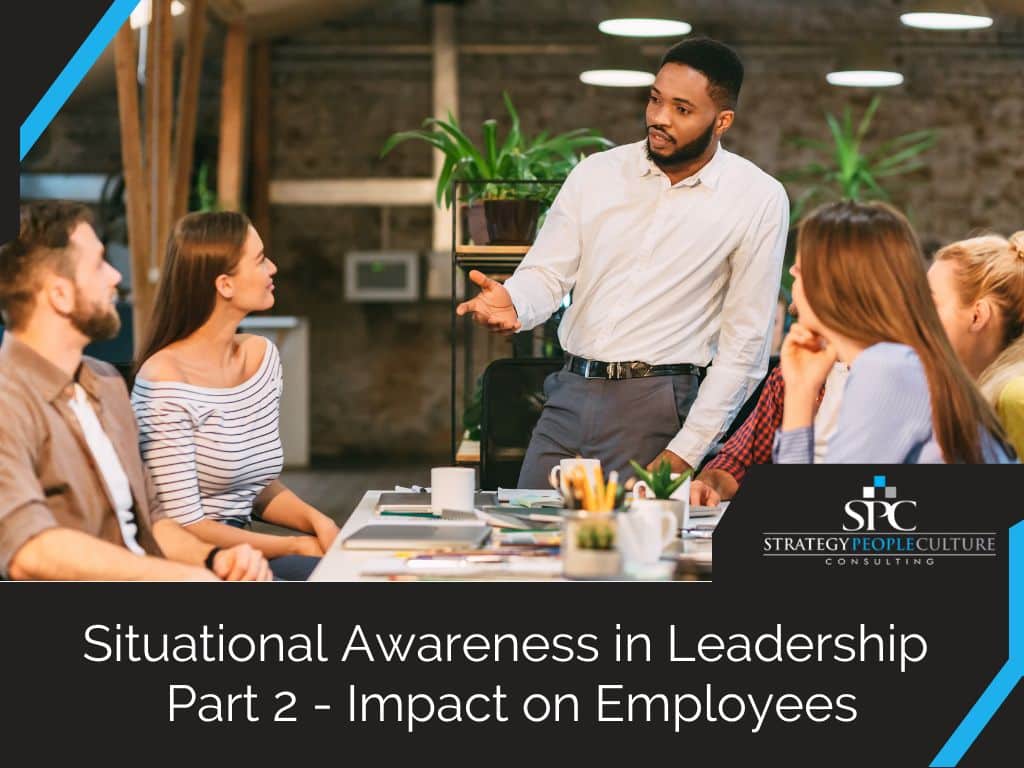Situational Awareness in Leadership Part 2 – Impact on Employees

Last week, we introduced the concept of situational awareness – the ability to perceive your surroundings, properly interpret what is happening, and act according to what you determine may happen next. We also briefly presented cases where situational awareness is critical to leadership. In this article, we’ll expand on those cases to give a better understanding of how situational awareness improves employee experience and, in turn, improves productivity and project outcomes.
The Impact of Missing Situational Awareness in Leadership

Business leaders have many pressures in their day-to-day lives to focus on. But at the end of the day, their main focus is simply stated: deliver what the customer wants, when they want it, and get paid to keep the company profitable.
However, by focusing on this goal, we can become so absorbed by the details of tasks and deadlines that we forget there are people involved in completing these tasks by those deadlines. Or we think those people will just get to work, that they should know what needs to be done, and that everyone will just cooperate with each other. After all, we are all adults, right?
The reality is that we are all human. We all have pressures, not just at the office but at home. These pressures distract us. People have egos, and sometimes, we clash. Also, we come from different cultures with different norms, so what seems agreeable to someone may be offensive to someone else. These all get in the way of those tasks and deadlines. If leaders fail to be situationally aware of these human interaction subtleties, the overall effect is that we become “that guy” in the Volkswagon commercial we mentioned in part one. That is, instead of focusing on how we can help the people we count on to deliver what the customer wants, we become absorbed by meeting deliverables and our individual agendas to the exclusion of noticing the humans around us that also need to get on with their day.
As we saw in part one, this can negatively impact meeting our business goals. That is, by focusing solely on tasks and not noticing our behavior’s impact on our team, we can stall the progress we seek and jeopardize desired outcomes.
Let’s look at some examples in more detail.
Situational Awareness and Work Conversations

Not every conversation in the office is about work. Leaders like Dick Vermeil have demonstrated that having a rapport with your team is extremely important to effective leadership. Asking employees about their day or even small talk can help establish this positive rapport.
But what if you, as a leader, dominate the conversation with your own life stories? Or what if you mention your great weekend in the Hamptons while an employee, unbeknownst to you, is struggling with financial hardship, such as a child with a medical issue? It is unlikely that your team will say anything to you – after all, you’re the boss. But they will likely feel uncomfortable nonetheless. Done enough times, this could lead to employees feeling disheartened and less committed to their work.
Recall from part one that situational awareness requires building a mental framework based on experience. Leaders who speak without sensitivity to another’s struggles are generally not thoughtless people. They simply haven’t experienced what the other person is going through, so they don’t have that framework in place to circumvent appearing insensitive in some conversations. The best way to improve situational awareness in these circumstances is to listen first, then speak if appropriate. This can only broaden a leader’s mental framework to tap into for future encounters. This has the added benefit of getting to know your employees better, to influence them through inspirational appeal.
Situational Awareness of Performance Metrics

Sometimes a lack of situational awareness can present unintended hardships for employees when quotas or goals set by management teams are unrealistic. For example, in one Undercover Boss episode, the COO of a company discovered their truck drivers’ routes and required number of daily stops, leaving them no time to visit a proper bathroom. This was having a negative impact on employees, especially female ones. In this case, the lack of situational awareness even created unintended gender bias issues. Moreover, this type of quota could even introduce safety issues if drivers feel they need to travel faster to meet quotas and deadlines.
Clearly, situational awareness of employees’ daily experiences could have avoided this problem. However, when a leader is aloof, employees may suffer. And, if the negative consequences spill over into the public, the corporate image may also suffer.
Situational Awareness of Process

In part one, we introduced the idea that leaders should notice when a process or policy impedes employee progress. This type of situational awareness is especially important since the potential issues they cause are fully within a business leader’s control. In other words, when process- or policy-related obstacles occur, a business leader becomes “that guy” of the corporate world.
What are some examples of this? The more obvious ones are tech related. New tracking systems or other tools meant to increase efficiency can sometimes be clumsy or add unreasonable extra steps to a worker’s day. Likewise, tools that generate data as input to decision-making are popular business investments that can frustrate employees and create unintended inefficiencies. These tools will only affect the bottom line positively if they are efficient to use. In these cases, it is again important to listen to employees. Some inefficiencies can be fixed by making design changes to the tools with user input. But others can be corrected simply by communicating better to employees the business reason behind the tool or process and by making sure employees have adequate training.
When you take the time to listen to workers’ pain points, you gain the experience needed for situational awareness that avoids future issues.
Situational Awareness and Accomplishment

Performance metrics, processes, and tools are all meant to move the company forward. That is, they are typically geared toward productivity. After all, productivity drives the corporate bottom line. But sometimes, a well-meaning leader can focus too much on productivity at the expense of situational awareness in times of accomplishment.
When your team finishes a big project by the deadline, do you take the time to celebrate and appreciate your team? Or do you buckle down and move on to the next project with little acknowledgment of the extra effort put in by others? If you do the latter, do you have the situational awareness to see the effect on your team’s morale? Moving on to the next set of tasks may seem efficient and, of course, necessary. But a team that feels deflated or unappreciated may lose the desire to go above and beyond moving forward.
Why Situational Awareness Matters for Effective Leadership
As these examples show, a boss who doesn’t pay attention to the people around them can unintentionally create issues that are very distracting to a team. Rather than focus on the work, the team can become preoccupied with day-to-day annoyances served up by a leader they view as out of touch. And this can sabotage any policies, processes, or project planning aimed at increasing efficiency.
We Can Help
Want to improve your situational awareness? Having an executive coach can lend the needed objectivity to the process. We at Strategy People Culture have been helping corporate leaders achieve their personal best for over 10 years. Call us at (833) ROCK – SPC or (833-762-5772) or email us at info@strategypeopleculture.com for more information.
